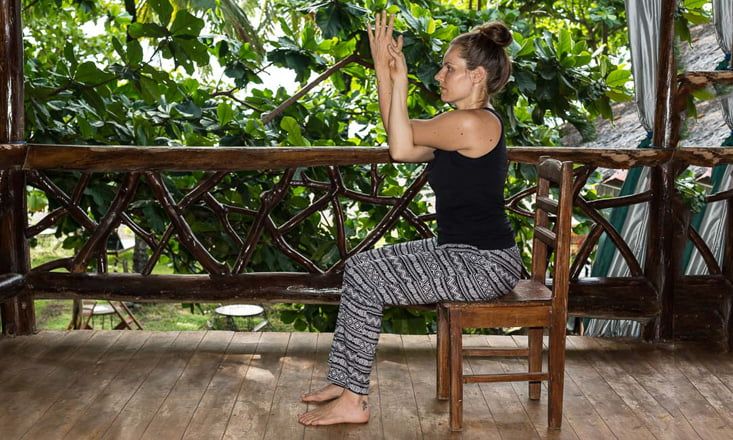We’ve all been there: we get halfway through the day and our head is screaming, our temples are aching, our jaw is locked—we have a headache. We may choose to drink some water or pop some pain-relieving medication and go about our business, but is there something more we could be doing to resolve our headaches?
From quick fixes in the moment to more long-term lifestyle changes, from specific poses to general remedies, yoga can help prevent and reduce headaches that may be plaguing you. Let’s go through the best options for yoga-inspired headache relief, and explore why and how they work.
1. Start Simple—Just Breathe
Breathing deeply is good for relieving muscle tension all over your body, as well as lowering your blood pressure. Breathing deeply and slowly slows your heart rate, and increases the amount of oxygenated blood that’s getting to your brain, which can immediately help you feel more clear-headed.
Reduced blood flow to the brain has been noted in several studies as being related to the onset of migraines. Breathing exercises also give you an opportunity to stop and assess what factors may be contributing to your pain—is it the way you’re sitting, have you been looking at your screen too long, are you drinking enough water?
Use these deep breaths as a time to close your eyes and reflect, and see if anything needs to change in your posture or your environment.
2. Develop a Regular Yoga Practice
If you suffer from regular migraines, studies show that practicing yoga regularly reduces “headache activity, medication intake, symptoms, and stress perception” in patients who participated in long-term yoga therapy compared to those who did not.
This is most likely due to whole host of physiological and psychological benefits of yoga, including muscle strengthening and relaxation, lowered stress hormones, and improved immune strength.
3. Relieve Tension with Therapeutic Touch
A yoga practice in which the instructor provides touch-based assistance and alignment cues can also help with any tension that may be contributing to pain. The therapeutic touch (TT) that some yoga instructors may provide has been shown to provide a significant improvement in the intensity of a tension headache—even over what would be expected of the placebo effect.
In some people, touch like this can release ‘happy’ neurotransmitters such as dopamine and serotonin, which help relieve tension and dull pain. This is not the case for everyone, however, so as yoga instructors, we should always ask before touching anyone in our classes, especially those who come to us with pain.
In a pinch, you can also massage yourself, taking your fingers and pressing them over your temples or your jaw to relieve the stress you’re holding in your facial muscles.
4. Practice Inversions
Again, where a headache may be caused by lack of proper blood flow in the vessels around the brain, an inversion can be the perfect fix to get lots of blood above the neck. This can be as simple as Downward Facing Dog or Forward Fold, or if you’re advanced, try headstand.
If you’re in a significant amount of pain, however, try not to practice any inversions with your feet off the ground, as your balance and strength may be impaired by your pain. If you do practice full inversions, try them with the support of a wall.
Inversions can also be a good solution for headaches caused by sinus pain. It may feel very intense at first in the places where you’re feeling the pressure, but a simple, warm-up flow followed by several inversions of your choice can loosen up that painful mucus and make it easier to expel.
Try a short, gentle flow with some upside-down poses, and then try irrigating your nose with a Neti pot (and sterilized, warm salt water!) and/or blowing your nose.
5. Try These Specific Poses
Cat-Cow pose and Child’s pose can be great for relieving tension and stress in the neck and shoulders, which may be radiating up into your head.
The same can be said for gentle twists, such as open Seated twist or Supine twist, because they release the long muscles on either side of your spine that are connected to the neck’s smaller muscles, which are in turn connected to the base of your skull.
Trying standing in a gentle Forward Fold with your feet hip-width apart and let your hands dangle or grasp your opposite elbow in your opposite palm, then mildly shake your head ‘no’ and ‘yes’. This uses gravity to help loosen the neck muscles and vertebrae, providing some gentle relief.

So yes, yoga can go a long way toward both preventing and treating headaches. Practicing yoga as part of a beneficial lifestyle change as a whole (including diet, exercise, and prioritizing your mental health and stability) can lead to a reduction in chronic aches and pains, generalized inflammation, and headache frequency and severity.
Try out one of these poses the next time you find yourself battling a headache, or try implementing some of these tips and let us know how it goes in the comments below.
Image Credit: Odette Hughes





